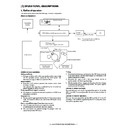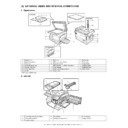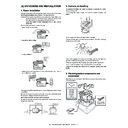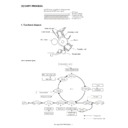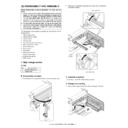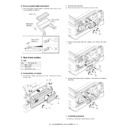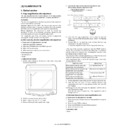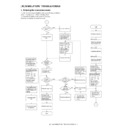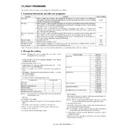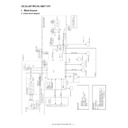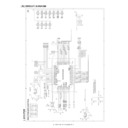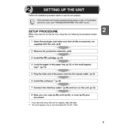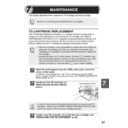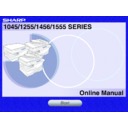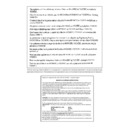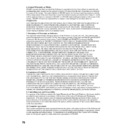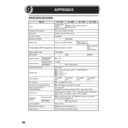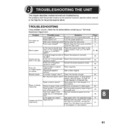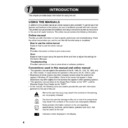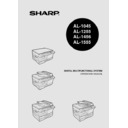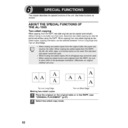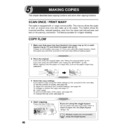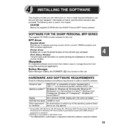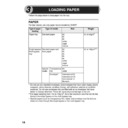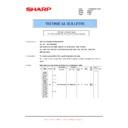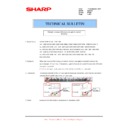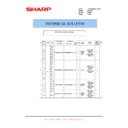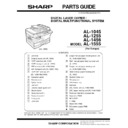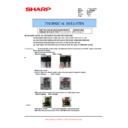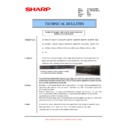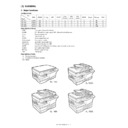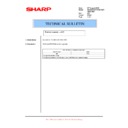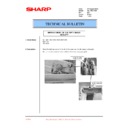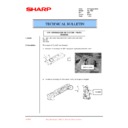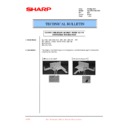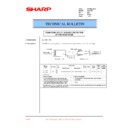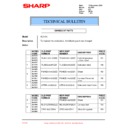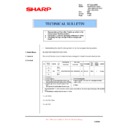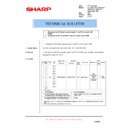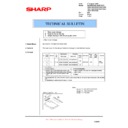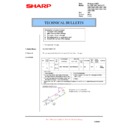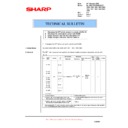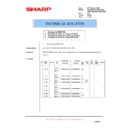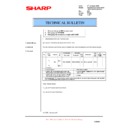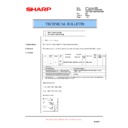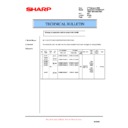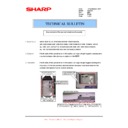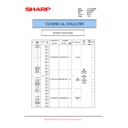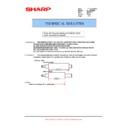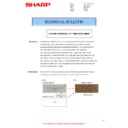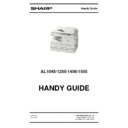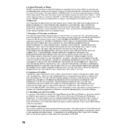Read Sharp AL-1456 (serv.man8) Service Manual online
AL-1555 OPERATIONAL DESCRIPTIONS 7 - 1
[7] OPERATIONAL DESCRIPTIONS
1. Outline of operation
The outline of operation is described referring to the basic configuration.
(Basic configuration)
(Outline of copy operation)
Setting conditions
1) Set copy conditions such as the copy quantity and the copy density
with the operation section, and press the COPY button. The
information on copy conditions is sent to the MCU.
information on copy conditions is sent to the MCU.
Image scanning
2) When the COPY button is pressed, the scanner section starts
Photo signal/Electric signal conversion
3) The image is converted into electrical signals by the CCD circuit
and passed to the MCU.
Image process
under the revised conditions and sent to the LSU (laser unit) as
print data.
print data.
Electric signal/Photo signal (laser beam) conversion
5) The LSU emits laser beams according to the print data.
(Electrical signals are converted into photo signals.)
6) The laser beams are radiated through the polygon mirror and
various lenses to the OPC drum.
Printing
7) Electrostatic latent images are formed on the OPC drum according
to the laser beams, and the latent images are developed to be
visible images(toner images).
visible images(toner images).
8) Meanwhile the paper is fed to the image transfer section in
synchronization with the image lead edge.
9) After the transfer of toner images onto the paper, the toner images
are fused to the paper by the fusing section. The copied paper is
discharged onto the exit tray.
discharged onto the exit tray.
(Outline of printer operation)
The print data sent from the PC are passed through the I/F and the
MCU to the LSU. The procedures after that are the same as above 5)
and later.
MCU to the LSU. The procedures after that are the same as above 5)
and later.
(Outline of scanner operation)
The scan data are passed through the MCU and the I/F to the PC
according to the conditions requested by the PC or set by the opera-
tions with the operation panel.
according to the conditions requested by the PC or set by the opera-
tions with the operation panel.
Operation
section
Scanner section
CCD
MCU (Main control/image process section)
Printer/
Scanner I/F
Scanner I/F
USB or Parallel
PC
Note: The scanner function is effective
only by USB connection.
Laser beam
Paper exit
Fusing section
Paper transport section
Manual paper
feed section
Cassette paper
feed section
Printer section
LSU (Laser unit)
Laser diode, Polygon mirror lens
Laser diode, Polygon mirror lens
Process section
AL-1555 OPERATIONAL DESCRIPTIONS 7 - 2
2. Scanner section
A. Scanner unit
The scanner unit in the digital copier scans images.
It is composed of the optical unit and the drive unit. The optical unit
performs scanning in the main scan direction with the light receiving
elements (color CCD). The drive unit performs scanning in the sub
scanning direction by moving the optical unit.
performs scanning in the main scan direction with the light receiving
elements (color CCD). The drive unit performs scanning in the sub
scanning direction by moving the optical unit.
B. Optical system
Two white lamps are used as the light source.
Light radiated from the light source is applied to the document on the
document table. The reflected light from the document is reflected 5
times by No. 1 - No. 3 mirrors and passed through the reduction lens to
form images on the light-receiving surface of 3-line CCD.
document table. The reflected light from the document is reflected 5
times by No. 1 - No. 3 mirrors and passed through the reduction lens to
form images on the light-receiving surface of 3-line CCD.
The light-receiving surface of the color CCD is provided with 3 line
scanning sections for RGB. Separate images scanned in each color
section are overlapped to complete color scanning. (When PC scan-
ning)
scanning sections for RGB. Separate images scanned in each color
section are overlapped to complete color scanning. (When PC scan-
ning)
The resolution is 600dpi.
When copying, only the green component is used to print with the
printer.
printer.
The color component for printing can be switched to red or blue by the
service simulation.
service simulation.
(Spectrum characteristics of the lamp)
(Spectrum characteristics of the color CCD)
(Optical unit)
C. Drive system
The drive system is composed of the scanner motor, the pulley gear,
the idle pulley, the idle gear, the belt 473, the belt 190, and the shaft.
the idle pulley, the idle gear, the belt 473, the belt 190, and the shaft.
The motor rotation is converted into reciprocated movements of the
belt 473 through the idle gear, the pulley gear, the belt 190, and the
idle pulley to drive the optical unit.
belt 473 through the idle gear, the pulley gear, the belt 190, and the
idle pulley to drive the optical unit.
MBVM26W25W260NLH/G
0.00E+00
1.00E-01
2.00E-01
3.00E-01
4.00E-01
5.00E-01
6.00E-01
0
200
400
600
800
Wave length (nm)
Intensity of UV
Lamp : MBVM26W25W260NLH/G
Lamp current : 5mA
Temp. : 25 degree
Lamp current : 5mA
Temp. : 25 degree
1
Table glass
2
Optical unit
3
Lens
4
Mirror 1
5
Mirror 2
6
Mirror 3
7
CCD PWB
8
Lamp
9
Reflector
1
9
8
10
8
9
7
3
5
4
2
6
1
Scanner motor
2
Pulley gear
3
Idle pulley
4
Belt 473
5
Belt 190
6
Optical unit
7
Shaft
8
Idle gear
9
7
3
4
6
2
8
5
1
3
AL-1555 OPERATIONAL DESCRIPTIONS 7 - 3
3. Laser unit
The image data sent from the MCU (image process circuit) is sent to
the LSU (laser unit), where it is converted into laser beams.
the LSU (laser unit), where it is converted into laser beams.
A. Basic structure
The LSU unit is the writing section of the digital optical system.
The semiconductor laser is used as the light source, and images are
formed on the OPC drum by the polygon mirror and f
formed on the OPC drum by the polygon mirror and f
θ
lens, etc.
The laser beams are passed through the collimator lens, the cylindrical
lens, the polygon mirror, the f
lens, the polygon mirror, the f
θ
lens, and the mirror to form images on
the OPC drum in the main scanning direction. The laser emitting PWB
is provided with the APC (auto power control) in order to eliminate fluc-
tuations in the laser power. The BD PWB works for measurement of
the laser writing start point.
is provided with the APC (auto power control) in order to eliminate fluc-
tuations in the laser power. The BD PWB works for measurement of
the laser writing start point.
Makes the laser scanning speeds at both ends of the drum same as
each other.
each other.
B. Laser beam path
C. Composition
Effective scanning width: 216mm (max.)
Resolution: 600dpi
Beam diameter: 75um in the main scanning direction, 80um in the sub
scanning direction
scanning direction
Image surface power: 0.17 ±0.01mW (Laser wavelength 770 - 795nm)
Polygon motor section: Brushless motor 20.787rpm
No. of mirror surfaces: 6 surfaces
No. of mirror surfaces: 6 surfaces
4. Fuser section
No
Component
Function
1
Semiconductor laser
Generates laser beams.
2
Collimator lens
Converges laser beams in parallel.
3
Polygon mirror,
polygon motor
polygon motor
Reflects laser beams at a constant rpm.
4
BD (Mirror, lens, PWB) Detects start timing of laser scanning.
5
f
θ
lens
Converges laser beams at a spot on the
drum.
drum.
Makes the laser scanning speeds at both
ends of the drum same as each other.
(Refer to the figure below.)
ends of the drum same as each other.
(Refer to the figure below.)
1
2
3
4
5
a
≠
b
≠
c
a
b
c
d = e = f
d
e
f
f
θ
LENS
AL-1555 OPERATIONAL DESCRIPTIONS 7 - 4
A. General description
General block diagram (cross section)
Top view
(1) Heat roller
A Teflon roller is used for the heat roller and a silicone rubber roller is
used for the lower heat roller for better toner fusing performance and
paper separation.
used for the lower heat roller for better toner fusing performance and
paper separation.
(2) Separator pawl
Three separator pawls are used on the upper heat roller. The separa-
tor pawls are Teflon coated to reduce friction with the roller and prevent
a smear on the paper caused by the separator pawl.
tor pawls are Teflon coated to reduce friction with the roller and prevent
a smear on the paper caused by the separator pawl.
(3) Thermal control
1) The heater lamp, thermistor, main PWB, DC power supply PWB,
and triac within the power supply unit are used to control the
temperature in the fuser unit.
To prevent against abnormally high temperature in the fuser unit, a
thermal breaker and thermal fuse are used for safety purposes.
temperature in the fuser unit.
To prevent against abnormally high temperature in the fuser unit, a
thermal breaker and thermal fuse are used for safety purposes.
2) The surface temperature of the upper heat roller is set to 165 -
190°C. The surface temperature during the power save mode is
set to 100°C.
set to 100°C.
3) The self-check function comes active when one of the following
malfunctions occurs, and an "H" is displayed on the multicopy
window.
window.
a. When the heat roller surface temperature rises above 240°C.
b. When the heat roller surface temperature drops below 100°C during
the copy cycle.
c. Open thermistor
d. Open thermal fuse
e. When the heat roller temperature does not reach 190°C within 27
second after supplying the power.
(4) Fusing resistor
Fusing resistor
This model is provided with a fusing resistor in the fusing section to
improve transfer efficiency.
improve transfer efficiency.
Since the upper heat roller is conductive, when using copy paper that
contains moisture and the distance between the transfer unit and the
fusing unit is short, the transfer current may find a path to ground via
the copy paper, the upper heat roller and the discharging brush.
contains moisture and the distance between the transfer unit and the
fusing unit is short, the transfer current may find a path to ground via
the copy paper, the upper heat roller and the discharging brush.
5. Paper feed section and paper transport
section
A. Paper transport path and general operations
Paper feed is made in two ways; the tray paper feed and the manual
paper feed. The tray is of universal-type, and has the capacity of 250
sheets.
paper feed. The tray is of universal-type, and has the capacity of 250
sheets.
The front loading system allows you to install or remove the tray from
the front cabinet.
the front cabinet.
The general descriptions on the tray paper feed and the manual paper
feed operation are given below.
feed operation are given below.
Separator pawl
PPD2
Thermal fuse
Thermistor
Heat roller
Paper guide
Pressure roller
Heat roller
Thermistor
Thermal fuse
Heater lamp
Separator pawl
Safety device
(thermal breaker, thermal
fuse)
(thermal breaker, thermal
fuse)
Triac (in the
power supply unit)
power supply unit)
Heated by the heater
lamp. (950W)
The surface temperature
of the upper heat roller is
sensed by the thermistor.
of the upper heat roller is
sensed by the thermistor.
Level of the thermistor is
controlled by the main PWB.
controlled by the main PWB.
With the signal from the
main PWB, the triac is
controlled on and off.
(power supply PWB)
main PWB, the triac is
controlled on and off.
(power supply PWB)
1
Scanner unit
8
Drum
2
Copy lamp
9
Transfer unit
3
LSU (Laser unit)
10
Pickup roller
4
Paper exit roller
11
Manual paper feed tray
5
Main charger
12
Manual paper feed roller
6
Heat roller
13
PS roller unit
7
Pressure roller
14
Paper feed roller
1
5
4
3
7
6
8
9
11
12
13
14
10
2

